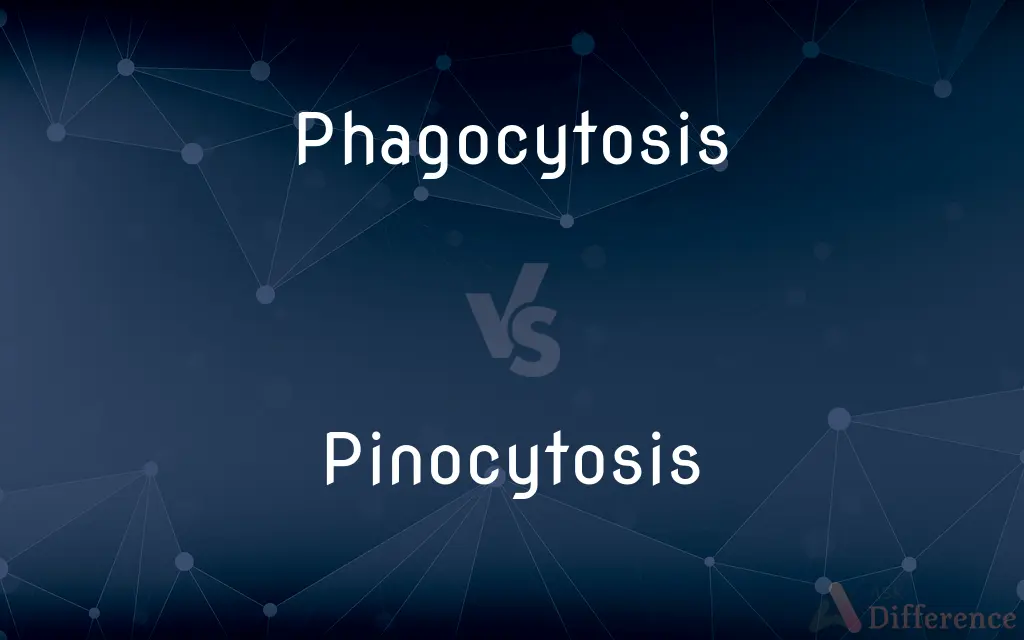Phagocytosis vs. Pinocytosis — What's the Difference?
Edited by Tayyaba Rehman — By Maham Liaqat — Updated on April 21, 2024
Phagocytosis involves the ingestion of large particles like bacteria, while pinocytosis is the process of cell drinking, absorbing fluid and solutes.

Difference Between Phagocytosis and Pinocytosis
Table of Contents
ADVERTISEMENT
Key Differences
In phagocytosis, the cell membrane extends around the target particle to form a phagosome, which is often triggered by specific binding to the particle. On the other hand, pinocytosis occurs continuously in most cells and involves the formation of small vesicles that non-specifically engulf extracellular fluid.
The contents of phagocytic vesicles are typically digested by fusion with lysosomes, a process vital for destroying harmful pathogens and recycling cellular components. Conversely, in pinocytosis, the engulfed fluid and solutes are often processed differently, primarily used for nutrient uptake or signal transduction.
Phagocytosis is highly selective, depending on receptor-mediated recognition of targets, which adds a layer of specificity to immune responses. In contrast, pinocytosis is generally a non-selective process, with cells absorbing a variety of dissolved substances from their environment.
Cells that are specialized for phagocytosis include macrophages and neutrophils, key players in the immune system. Meanwhile, pinocytosis is a more universal cellular activity, observed across numerous cell types, including endothelial and epithelial cells.
Comparison Chart
Mechanism
Membrane extensions form phagosome
Membrane invaginates to form vesicles
ADVERTISEMENT
Specificity
Highly selective, receptor-mediated
Generally non-selective
Cellular Process
Fusion with lysosomes for digestion
Vesicles may fuse with other organelles
Typical Cells
Macrophages, neutrophils
Widespread among many cell types
Compare with Definitions
Phagocytosis
Involves the extension of cellular membranes to capture targets.
During phagocytosis, a neutrophil extends pseudopodia to enclose a bacterium.
Pinocytosis
Cellular process of ingesting extracellular fluid and its contents.
Pinocytosis allows cells to absorb nutrients dissolved in the surrounding fluid.
Phagocytosis
Results in the formation of a phagosome.
The phagosome formed during phagocytosis fuses with lysosomes for digestion.
Pinocytosis
Leads to the formation of small vesicles.
The vesicles from pinocytosis merge with endosomes for sorting of solutes.
Phagocytosis
Cellular process of engulfing large particles or cells.
Phagocytosis enables macrophages to remove pathogens from the bloodstream.
Pinocytosis
Common in many types of cells.
Pinocytosis is a key mechanism for fluid uptake in kidney cells.
Phagocytosis
Selective and receptor-mediated process.
Phagocytosis in macrophages is triggered by the detection of foreign antigens.
Pinocytosis
Involves the invagination of the cell membrane.
Small vesicles form during pinocytosis as the cell membrane folds inward.
Phagocytosis
Essential for immune defense and debris clearance.
Phagocytosis by immune cells plays a critical role in clearing infected tissues.
Pinocytosis
Non-selective uptake mechanism.
Pinocytosis occurs continuously in endothelial cells lining blood vessels.
Phagocytosis
Phagocytosis (from Ancient Greek φαγεῖν (phagein) 'to eat', and κύτος, (kytos) 'cell') is the process by which a cell uses its plasma membrane to engulf a large particle (≥ 0.5 μm), giving rise to an internal compartment called the phagosome. It is one type of endocytosis.
Pinocytosis
In cellular biology, pinocytosis, otherwise known as fluid endocytosis and bulk-phase pinocytosis, is a mode of endocytosis in which small particles suspended in extracellular fluid are brought into the cell through an invagination of the cell membrane, resulting in a suspension of the particles within a small vesicle inside the cell. These pinocytotic vesicles then typically fuse with early endosomes to hydrolyze (break down) the particles.
Phagocytosis
The engulfing and destruction of particulate matter, such as a bacterium, by a cell.
Pinocytosis
Introduction of fluids into a cell by invagination of the cell membrane, followed by formation of vesicles within the cell.
Phagocytosis
A form of endocytosis in which a cell incorporates a particle by extending pseudopodia and drawing the particle into a vacuole of its cytoplasm.
Pinocytosis
(biology) A form of endocytosis in which material enters a cell through its membrane and is incorporated in vesicles for digestion.
Phagocytosis
Process in which phagocytes engulf and digest microorganisms and cellular debris; an important defense against infection
Pinocytosis
Process by which certain cells can engulf and incorporate droplets of fluid
Common Curiosities
How do phagocytosis and pinocytosis differ in their impact on cell function?
Phagocytosis primarily helps in defense and debris clearance, while pinocytosis mainly aids in nutrient uptake and maintaining cellular homeostasis.
Why is phagocytosis important in the immune system?
Phagocytosis is crucial because it allows immune cells to capture and destroy pathogens, preventing infections.
What triggers phagocytosis in cells?
Phagocytosis is usually triggered by the binding of a particle to cell surface receptors, signaling the cell to engulf it.
Can pinocytosis occur in all types of cells?
Yes, pinocytosis is a fundamental cellular process that occurs in almost all types of cells, allowing them to absorb nutrients and other substances.
What is the fate of substances taken up by pinocytosis?
Substances absorbed by pinocytosis are typically sorted in endosomes and may be used as nutrients, degraded, or recycled within the cell.
How does the mechanism of vesicle formation differ between phagocytosis and pinocytosis?
In phagocytosis, vesicles form through the outward extension and wrapping of the cell membrane around a particle, while in pinocytosis, the cell membrane folds inward to form vesicles.
What is the energy source for phagocytosis?
Phagocytosis uses ATP as an energy source, which is necessary for the movement and remodeling of the cell membrane.
What role do lysosomes play in phagocytosis?
Lysosomes fuse with phagosomes to form a digestive compartment where ingested materials are degraded and processed.
How is the vesicle size different between phagocytosis and pinocytosis?
Vesicles formed in phagocytosis are typically larger, containing bigger particles, compared to the smaller vesicles in pinocytosis.
Is phagocytosis a form of active or passive transport?
Phagocytosis is a form of active transport because it requires energy to move substances against their concentration gradient and to change the shape of the cell membrane.
What substances are typically absorbed through pinocytosis?
Pinocytosis often absorbs fluids and small molecules like sugars, amino acids, and various ions.
What are some diseases associated with defective phagocytosis?
Defects in phagocytosis can lead to diseases such as chronic granulomatous disease, where the immune system fails to effectively kill bacteria.
Does pinocytosis involve receptor molecules like phagocytosis?
Unlike phagocytosis, pinocytosis generally does not involve specific receptor molecules and is considered a form of non-selective uptake.
How do temperature and pH affect pinocytosis and phagocytosis?
Both processes can be influenced by temperature and pH; lower temperatures and unfavorable pH levels typically reduce the rates of vesicle formation and processing.
Can pinocytosis contribute to pathogen entry into cells?
Yes, some viruses and toxins exploit pinocytosis as a means to enter cells, bypassing other more selective cellular entry mechanisms.
Share Your Discovery

Previous Comparison
Bearing vs. Bushing
Next Comparison
Swim vs. SwimmingAuthor Spotlight
Written by
Maham LiaqatEdited by
Tayyaba RehmanTayyaba Rehman is a distinguished writer, currently serving as a primary contributor to askdifference.com. As a researcher in semantics and etymology, Tayyaba's passion for the complexity of languages and their distinctions has found a perfect home on the platform. Tayyaba delves into the intricacies of language, distinguishing between commonly confused words and phrases, thereby providing clarity for readers worldwide.















































